Table of Contents
Introduction to Vehicle Speed Sensors
Vehicle speed sensors play a pivotal role in modern automobiles, feeding vital speed data to various systems, and ensuring smooth operation and safety. Grasping the functionality of these sensors is crucial for diagnosing any issues they may encounter.

Significance of Vehicle Speed Sensors
Vehicle Speed Sensors (VSS) play a critical role in the functionality of modern vehicles, serving as a vital component in the vehicle’s transmission system and ensuring optimal performance. The significance of vehicle speed sensors extends to several crucial aspects of vehicle operation and safety. Here’s an in-depth look at the importance of vehicle speed sensors:
Speedometer Operation

The VSS provides real-time speed data to the vehicle’s speedometer, ensuring that drivers have accurate information about their current speed. This is crucial for safe driving and adherence to speed limits.
Transmission Performance
The sensor’s data is essential for the proper functioning of the vehicle’s transmission. It helps the transmission control module (TCM) determine when to shift gears for optimal performance and fuel efficiency.
Cruise Control

For vehicles equipped with cruise control, the VSS is fundamental in maintaining the set speed. It continuously monitors the vehicle’s speed and makes adjustments to the throttle accordingly to keep the speed consistent.
Engine Management
The engine control unit (ECU) uses speed sensor data to adjust engine functions such as fuel injection and ignition timing, balancing power output and fuel efficiency based on the vehicle’s speed.
Anti-lock Braking System (ABS)

The VSS is part of the ABS system, helping to prevent wheel lock-up by adjusting the brake pressure during sudden stops. By monitoring vehicle speed, the ABS system can provide maximum braking power without compromising control.
Traction Control

For vehicles with traction control systems, the VSS helps monitor and adjust the power supplied to the wheels, preventing wheel spin and loss of control, especially in slippery conditions.
Odometer Functionality
The sensor contributes to the odometer’s accuracy by providing data on the distance traveled, which is essential for maintenance schedules and determining the vehicle’s value.
Fuel Efficiency

By ensuring optimal gear shifts and engine performance, the VSS indirectly contributes to fuel efficiency, reducing unnecessary fuel consumption and emissions.
Emission Control

Modern vehicles use VSS data as part of their strategy to control emissions. By adjusting the engine’s operation based on speed, the vehicle can minimize the emission of harmful pollutants.
In summary, the Vehicle Speed Sensor is integral to various vehicle systems, influencing everything from performance and safety features to fuel efficiency and emission control. Its accurate and reliable operation is crucial for the overall functionality of the vehicle. Any issues with the VSS can lead to noticeable problems in vehicle performance, emphasizing the importance of timely maintenance and sensor health monitoring.
Symptoms of a Bad Vehicle Speed Sensor
A faulty vehicle speed sensor (VSS) can lead to a range of issues, affecting various aspects of vehicle performance and safety. Recognizing the symptoms of a bad VSS is crucial for timely diagnosis and repair. Here are the common symptoms that may indicate a problem with the vehicle speed sensor:
Malfunctioning Speedometer

One of the most noticeable signs of a bad VSS is a speedometer that either doesn’t work at all, gives erratic readings, or fluctuates while driving. This is because the speedometer relies on the VSS to display the vehicle’s speed.
Erratic Transmission Behavior
If the VSS is malfunctioning, the transmission may not shift gears appropriately or might shift erratically. This happens because the transmission control system relies on the speed sensor to determine the optimal timing for gear changes.
Check Engine Light

A faulty VSS can trigger the Check Engine light on the dashboard. This occurs when the vehicle’s computer detects an issue with the signal from the speed sensor.
Poor Fuel Economy
Since the VSS is involved in optimizing engine performance, a malfunctioning sensor can lead to poorer fuel economy. The vehicle’s computer may not receive accurate speed data, leading to suboptimal engine performance and increased fuel consumption.
Cruise Control Issues
If your vehicle’s cruise control is not maintaining the set speed or is not engaging at all, it could be due to a faulty VSS. The cruise control system depends on the speed sensor to regulate the vehicle’s speed.
Harsh or Improper Shifting
Without accurate speed information from the VSS, automatic transmissions may experience harsh or improper shifting. The transmission control module may have trouble determining when to shift gears, resulting in a rough ride.
ABS or Traction Control Problems

For vehicles with ABS or traction control systems, a bad VSS can lead to issues with these systems. The ABS and traction control systems may become disabled if they do not receive accurate speed data.
Odometer Not Working
Since the VSS feeds information to the odometer, a malfunctioning sensor can lead to the odometer not working correctly or not advancing as it should.
Addressing issues with the vehicle speed sensor promptly is crucial, as a malfunctioning VSS can lead to safety concerns, decreased vehicle performance, and increased fuel consumption. If you experience any of these symptoms, it’s advisable to have your vehicle checked by a professional mechanic to diagnose and rectify the issue.
Diagnosing a Bad Vehicle Speed Sensor
Diagnosing a bad vehicle speed sensor (VSS) is a crucial step in ensuring your vehicle’s optimal performance and safety. A faulty VSS can lead to various issues, from erratic speedometer readings to transmission problems. Here’s how you can diagnose a bad vehicle speed sensor:
Check for Error Codes

- Use GaragePro OBD-II Scanner: Connect the GaragePro On-Board Diagnostics (OBD-II) scanner to your vehicle’s diagnostic port. If the VSS is malfunctioning, the scanner may display specific trouble codes indicating issues with the speed sensor or its circuit. Common codes include P0500 to P0503.
Inspect the Speed Sensor Physically
- Locate the VSS: Consult your vehicle’s service manual to locate the speed sensor. It’s typically found on the transmission.
Check for Visible Damage: Inspect the sensor and its connector for any visible signs of damage, corrosion, or loose connections.
Test the Sensor’s Voltage and Ground:
- Check Voltage Supply: Use a multimeter to check the voltage supply to the sensor. The voltage should match the specifications in the service manual.
- Check Ground Connection: Ensure the sensor has a good ground connection. A poor ground can cause erratic sensor operation.
Measure the Sensor’s Output Signal:
- Test Sensor Signal: A functioning VSS should produce an AC voltage signal that increases with vehicle speed. You can measure this signal with a multimeter set to the AC voltage setting. Rotate the wheels or drive the vehicle to check the signal.
Check the Wiring and Connectors:
- Inspect Wiring: Examine the wiring harness for any signs of damage, wear, or corrosion. Damaged wires can cause intermittent or incorrect signals.
- Check Connectors: Ensure that the connectors are clean, secure, and free of corrosion.
Compare the Sensor’s Performance:
- Reference Values: Compare the readings from your tests to the reference values specified in your vehicle’s service manual. Deviations from these values can indicate a faulty sensor.
Professional Diagnostic Equipment:
- Advanced Diagnostics: If the issue is still not clear, a professional mechanic can use more advanced diagnostic tools to assess the sensor’s performance. They can also check related systems like the ABS or transmission for any related issues.
If the diagnosis confirms a bad vehicle speed sensor, it’s important to replace it promptly to avoid further issues with your vehicle’s performance. Remember, accurate diagnosis and timely repairs are key to maintaining the safety and efficiency of your vehicle. If you’re unsure about any steps in the diagnostic process, it’s advisable to consult or seek the assistance of a professional mechanic.
Common Causes of Vehicle Speed Sensor Failure
Vehicle speed sensors (VSS) are crucial for the proper functioning of various systems in a vehicle, including the speedometer, transmission, and ABS. However, like all mechanical and electronic components, they can fail due to several reasons. Understanding the common causes of vehicle speed sensor failure can help in early diagnosis and prevention. Here are some key factors that lead to VSS failure:
- Wear and Tear: Over time, the VSS can experience natural wear and tear. Constant exposure to high temperatures and vibrations, typical in an automotive environment, can degrade the sensor’s components, leading to failure.
- Dirt and Debris: Accumulation of dirt, debris, or metal shavings can interfere with the sensor’s ability to accurately detect the rotational speed of the vehicle’s transmission output or wheel. This is especially common in sensors located near the road surface or within the transmission.
- Electrical Issues: Problems with the wiring, such as frayed wires, loose connections, or corrosion, can disrupt the electrical signals transmitted by the VSS. These issues can cause intermittent or inaccurate readings.
- Damage from External Factors: The VSS can be damaged by external factors such as road debris, water ingress, or physical impact during vehicle operation or maintenance activities.
- Corrosion: The sensor or its connector can become corroded, particularly in environments with high moisture or salt (such as areas with heavy road salt usage in winter). Corrosion can interrupt the electrical connections necessary for the sensor to function correctly.
- Faulty Installation: If a VSS has been recently replaced, improper installation can lead to failure. This includes incorrect positioning, inadequate connection to the wiring harness, or incorrect sensor type.
- Defective Manufacturing: In some cases, the VSS may fail prematurely due to manufacturing defects. This includes issues with the sensor itself or associated components like wiring and connectors.
- Failure of Related Components: Sometimes, the problem may not lie with the VSS itself but with related components. For example, a malfunctioning speedometer gear (in vehicles where the VSS is mechanically driven) can lead to sensor failure.
Regular maintenance and vehicle inspections can help identify potential issues with the vehicle speed sensor before they lead to more significant problems. Addressing any symptoms of VSS failure promptly is key to maintaining the proper functioning of the vehicle’s speedometer, transmission, and other related systems.
Fixing a Bad Vehicle Speed Sensor
Fixing a bad vehicle speed sensor (VSS) involves several steps to ensure that your vehicle’s transmission system, speedometer, and various other components function correctly. Here’s a structured approach to addressing a faulty VSS:
Accurate Diagnosis:
- Confirm that the VSS is the issue. Use an OBD-II scanner to check for error codes, and visually inspect the sensor and wiring for damage or wear.
Gather Necessary Tools and Parts:
- Ensure you have the correct replacement VSS for your vehicle model. You’ll also need basic tools like a ratchet, socket set, and possibly a special socket for the sensor, depending on your vehicle.
Locate the Vehicle Speed Sensor:
- The VSS is typically located on the transmission case or near the output shaft. Refer to your vehicle’s service manual for the exact location.
Remove the Faulty Sensor:
- Disconnect the electrical connector from the VSS.
- Remove any securing fasteners or clips.
- Carefully unscrew and remove the sensor. If it’s difficult to remove, ensure you’re using the correct tools and applying even pressure to prevent damage.
Inspect and Compare:
- Inspect the old sensor for signs of damage or wear.
- Compare the old sensor to the new one to ensure they are identical in size and design.
Install the New Sensor:
- Carefully insert the new sensor into the slot where the old one was removed. Ensure it’s properly seated and aligned.
- Screw in any fasteners or re-engage any clips to secure the sensor in place.
- Reconnect the electrical connector.
Test the Installation:
- Clear any error codes using an OBD-II scanner.
- Start the vehicle and take it for a test drive to ensure the speedometer and transmission are functioning correctly.
- Monitor the vehicle for any warning lights or unusual behavior.
Consult a Professional If Needed:
- If you encounter any issues during the diagnosis or repair process, or if the problem persists after replacing the VSS, it may be best to consult a professional mechanic. They can provide a more in-depth diagnosis and ensure the repair is performed correctly.
Remember, while replacing a VSS can be a straightforward task, it requires precision and care to ensure the new sensor functions correctly. Additionally, working on vehicle electrical systems can pose risks, so it’s essential to follow safety precautions and consult professional help if you’re unsure about any part of the process. Regular maintenance and addressing issues promptly can prevent further complications and ensure your vehicle remains in optimal condition.
Preventive Measures for Vehicle Speed Sensor Longevity
Certainly! Here’s a more concise version of preventive measures for Vehicle Speed Sensor (VSS) longevity:
- Regular Maintenance: Follow the vehicle’s maintenance schedule for early detection and resolution of VSS issues.
- Clean the Sensor Area: Periodically remove dirt and debris to ensure accurate sensor readings.
- Inspect Wiring: Regularly check for and address any signs of wear or corrosion in wiring and connectors.
- Avoid Water Damage: Protect the VSS from water during drives and engine cleaning.
- Mindful Driving: Avoid rough driving conditions that can lead to increased vibrations and potential sensor damage.
- Quality Parts: Use OEM or reputable aftermarket parts for any replacements to ensure compatibility and durability.
- Professional Installation: Opt for expert installation to avoid improper fitting and related sensor failures.
- Monitor Performance: Stay alert to changes in vehicle performance that may signal VSS issues.
- Prompt Addressal: Quickly attend to any suspected problems to prevent escalation and higher repair costs.
By following these points, you can significantly extend the life and reliability of your vehicle’s speed sensor.
Impact of a Bad Vehicle Speed Sensor on Driving Experience Ignoring the signs of a failing vehicle speed sensor can lead to degraded performance, safety risks, and even legal issues, making it crucial to address any symptoms promptly.
Conclusion
Timely identification and resolution of issues with your vehicle speed sensor are paramount. Understanding the symptoms, causes, and solutions not only ensures a smoother driving experience but also contributes to your vehicle’s longevity and safety.

